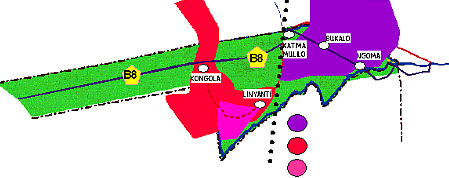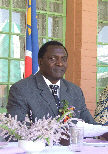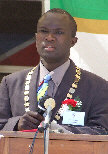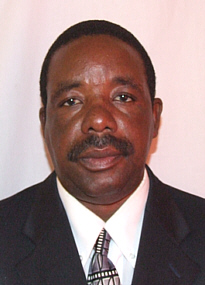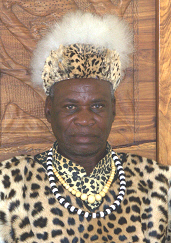
People of the Caprivi Region:
Geography & Ethnic Groups:
Long before borders and different countries existed in Africa, they people that lived in what is today Caprivi, South East Angola and the very upper part of Botswana and South Western Zambia is all part of the Ethnic Group of the Lozi. The Lozi people speak Silozi, which is until today the normal indigenous language of these regions. When borders was drawn onto the land, the Lozi people was split up, some even from their direct family that lived across the river.
Of the about 80,000 people in the Caprivi - according to the last census taken in 2004 - 17,000 are pure Lozi, while the others make up different sub-ethnic groups and have their own dialect of Lozi.
Mafwe people lives in South-Eastern Angola, down along the Kwando River to the Mudumu National Park. Mafwe people speak Sifwe. (Ma - meaning of people, Si meaning of nature)
Masubia make up the largest part of the Sub-ethnic groups, and is found in the Eastern Caprivi and up into Zambia. Masubia people’s dialect is called Sisubia.
The Mayeyi (Ma-Yea-Yi) and Mbukushu people live in the very southern tip of the Caprivi, and is very little in numbers. Although they live in the same region, they have separate little villages, where the Mayeyi speaks Siyeyi and the Mbukushu speak Mbuku.
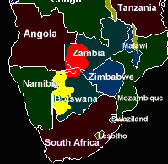


Location of all the Lozi speaking people. There is about 556,000 Lozi speaking people throughout.
Location of the San Bushmen. Their distribution in the Caprivi is very scarce and they live in villages in the Western Caprivi, inside Bwabwata National Park, where they speak San.
Masubia
Mafwe
Mayeyi and Mbukushu
Namibian Governing & Constituancy:
From the Namibian Government in the Caprivi, Governor Leonard Mwilima is the region's head. Every Constituancy in Namibia has a governor with councilors as head of that Constituancy.
Governor Mwilima started his term in 2008. Before that he was succeeded by Governer Bernard Sibalatani, who is now one of the main councelors in the Caprivi Constituancy.
And as with every town and city, Katima has a Mayor, currently Mayor John Likando. Katima is being managed by the Katima Mulilo Town Council.
Governor
L Mwilima
Councilor
B Sibalatani
Mayor
J Likando

Traditional Governing & Court Systems:
The Lozi People all obide by traditional laws as well as by the Law of Namibia. They still have strong traditional sense and is mostly self-supporting farmers.
The people are “governed” by the Kutha - the “governing” body of that area. A lot of petty crimes is sort out by the traditional Court, where the Kutha decides what to do with the people if found guilty. The punishments is mostly paying damages to the plaintiff, fees to the Kutha, community service etc. For larger crimes, the normal laws - police and Regional Court are contacted.
Kuthas are compiled out of the Litunga (Chief King) of the region, the Ngambela (Royal Advisor), The Natamoyo (Second Advisor), 3 X Senior Indunas (High Officers) , 6 X Junior Indunas (Officers) and some secretaries.
Thus, if a person has a problem and needs to address the Kutha, he will first approach one of the Junior Indunas. This Induna listenes and report to one of the Senior Indunas, if the problem is viable for the Kutha to address, thy will report to Natamoyo, which will in tun report to the Ngambela. The Ngambela will then inform the Chief. The Chief will then decide on a date where all can be present to address the problem in a Kutha-Meeting, which works just like a normal magistrate’s court, where the plaintiff will put his problem, witnesses will be there etc.
Should the Kutha need to give information to their people, the Litunga (Chief King) will relay the message to the Ngambela, which will relay the message to the Natamoyo. He will then speak to the Senior Indunas, who in turn will tell the Junior Indunas. The necessary people will then be contacted and informed in order to get the message out, in respect to importance. The Ngambela and Natamoyo will speak to the Governer and Councillours of the normal State Governmental Institutions, the Senior Indunas will speak to the Highest of local village chiefs, and the Junior Indunas will contact the normal village chiefs. The chiefs will then inform the people from the villages.
Ethnic Kutha: Every sub-ethnic group has their own Kutha. If the Kutha for that group cannot resolve a problem, it is referred to the ROYAL KUTHA. The Lozi People that is not part of one of the sub-ethnic groups, refer their problems directly to the Royal Kutha.
Sub-Ethnic Group: Chief Name:
Masubia Munintenge Kisco Liswani III
Mafwe Joseph Tembwe Mayuni
Mayeyi Shikati Bornface Lutibezi Shufu
Mbukushu Chief Mbambo
On the map is a black dotted line to show seperation of the ethnic and sub-ethnic groups to fall under the Royal Kutha of that part. There thus is two Royal Kuthas in the Caprivi.
The Masubia people and Lozi people to the east of the line (straight from just west of Katima and down partly along the road to Linyanti and Sangwali) will fall under the Royal Kutha of Litunga . Chief This Kutha is situated in Bukalo. ChiefKing Liswani III is thus chief for both the Masubia Kutha and the Bukalo Royal Kutha.
The Mafwe, Mayeyi, Mbukushu and Lozi people west of the line fall under the Linyanti Royal Kutha of Litunga George Simasiku Mamili.

A normal Caprivi Village. Most rural people live in these villages, and some of the residents in Katima Mulilo's Informal settlements also have mud and clay houses.
Subsistence Farmers
The People of the Caprivi is mostly subsistence farmers, meaning they farm in a small scale to survive. Near the rivers, they catch fish, and all have a few cattle, goats and chickens. They make small little farmlands where they plant mainly Mahangu, which is a grain sort and can be stamped into a fine powder that they use to make porridge with; they also plant mealies. They plant vegetables like Spinach, Cabbage, Chomolia and Marog, which is all leavy green vegetables like the spinach. They prepare these by cutting it up very finely, cooking it for a few minutes and then frying it in a bit of oil. This is eaten with porridge.
Cattle Farming A Zambezi Fishing Camp
The people live off the land, and seasonal fruits and vegetables and insects are eaten. In the rainy season, wild pumpkins called Marakkas is eaten, Mangos and Pawpaw trees are quite common in this sub tropic area, and have been brought in by missionaries, and planted quite widely.
Just before rain starts, it is excruciatingly hot in the Caprivi. This heat and the first few drops that fall tells the cicadas that is time to appear. Classified as the loudest beattles on earth, the cicadas may appear in their hundreds on one day, and flocks to lights, where they are harvested as protein rich foods, normally cleaned and fried in butter.
April normally starts the Mopanie Worm season, which is the most harvested worm/larvae/insect in southern Africa. Mopane worms is the larvae of the Mopane Moth, which normally lies their eggs in the Mopane trees. The Mopane worms lives off the leaves of the Mopane Tree. To read more about these worms, click HERE. (link not up yet)
Mokoro Commuting Interpretive Dances
The People travel on the rivers with MOKOROS, wooden canoes made mostly out of the trunks of Sausage Trees because the wood is light, easy to carve and water tight. From Forestry side, they may however not carve up these trees anymore, as the trees are now protected.
They like dancing while they play drums, and have reed skirts that plays a very “talkative” part in the dance routines. Certain dances plays out certain happenings in their traditional way of life.
Some interesting Customs:
As a manner of respect, Lozi People will clap their hands (Curled hands, not flat hands) and bend their knees slightly. Ladies may not wear pants when they are going to be in the presence of Indunas, the Ngambelo, Natamoyo and especially the Litunga. They have to wear a SiTENGE (stêng-gê) (wrap-around cloth) over pants should they be wearing pants in an emergency. Ladies also may not look the Litunga in the eyes.

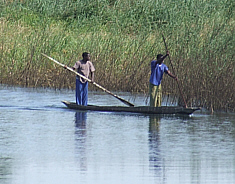
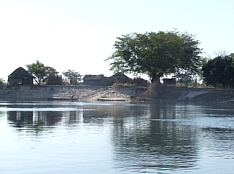

Common used Lozi words:
Thank You: Ni Tumezi (Nie Tu Mêzzi) (Usually goes with 2 handclaps)
Please: Mulikani ( Moe-lie-kaanie)
Come Here: Tahakuano (Ta-ha-kwaanoe)
Good Day: Mutozi (Moe-tozzzzie)
Go well: Tsamay Hande (Tsa-maaya Haandé)
Nothing: Hakuna (Ha-koena)
Water: Meizi (mê-zzi)
Porridge: Buhope / Sadza (Boe-hoppê, Sad-sa)
Litunga George Simasiku MAMILI. Litunga M Kisco LISWANI III
in his traditional dress at a photographed at a business
traditional event meeting in Katima Mulilo
Line to show traditional court values
Sub-Ethnic Distribution
Miss Namibia 2009
Jubilations & Congratulations to
Miss H Ntelamo, Miss Namibia of 2009, whom is a resident of the Caprivi. We are extremely proud of you and enjoyed the visit to Photo Quick Caprivi!! We wish you all the best during your reighn
and the very best of experience!!
Let the people know of the Caprivi!!



